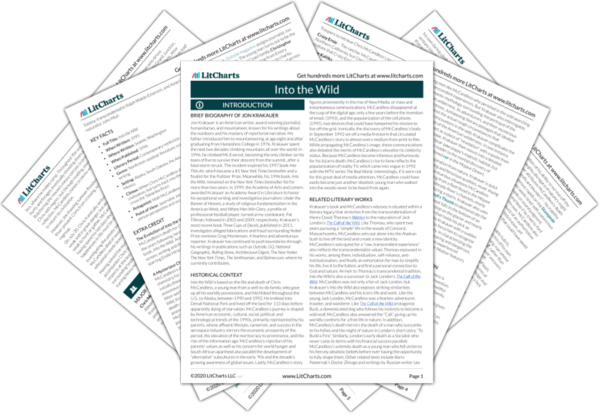Welcome to the LitCharts study guide on Jon Krakauer's Into the Wild. Created by the original team behind SparkNotes, LitCharts are the world's best literature guides.
Into the Wild: Introduction
Into the Wild: Plot Summary
Into the Wild: Detailed Summary & Analysis
Into the Wild: Themes
Into the Wild: Quotes
Into the Wild: Characters
Into the Wild: Symbols
Into the Wild: Theme Wheel
Brief Biography of Jon Krakauer

Historical Context of Into the Wild
Other Books Related to Into the Wild
- Full Title: Into the Wild
- When Written: 1995
- Where Written: Seattle, Washington
- When Published: 1996
- Literary Period: Contemporary nonfiction
- Genre: Nonfiction; outdoor literature; travel writing; nature writing
- Setting: Alaska, South Dakota, the American Southwest, and Mexico.
- Climax: When Chris McCandless decides to return to civilization, but turns back into the wild because he cannot cross the Teklanika River.
- Antagonist: Walt McCandless; nature
- Point of View: Journalist Jon Krakauer reports from a third person perspective and occasionally the first person.
Extra Credit for Into the Wild
The Evolution of Into the Wild. Jon Krakauer first covered McCandless’s death for Outside Magazine in January 1993. In the years following, he extended the article into a full-length book, Into the Wild. Actor Sean Penn adapted the book for the screen, writing and directing a critically acclaimed film version, starring Emile Hirsch, in 2007.
A Mysterious Chemistry. The confounding circumstances of McCandless’s death prompted Krakauer to turn to botany and chemistry for answers. In Outside magazine Jon Krakauer initially theorized that McCandless died because he mistook poisonous sweet pea seeds for those of an edible potato plant. After working with a team of chemists while writing Into the Wild, Krakauer proposed another theory for McCandless’s death—alkaloid poisoning from wild potato seeds. Krakauer amended his theory in later editions of the book, attributing McCandless’s death to paralysis and starvation by swainsonine poisoning. In 2013, Krakauer published an article in The New Yorker that definitively asserted McCandless’s death to be the result of lathyrism, a paralyzing neurological disease caused by a toxin in potato seeds, known as ODAP (beta-N-oxalyl-L-alpha-beta diaminoprionic acid). However, the case is not settled and there is still debate about what exactly caused McCandless's death.







